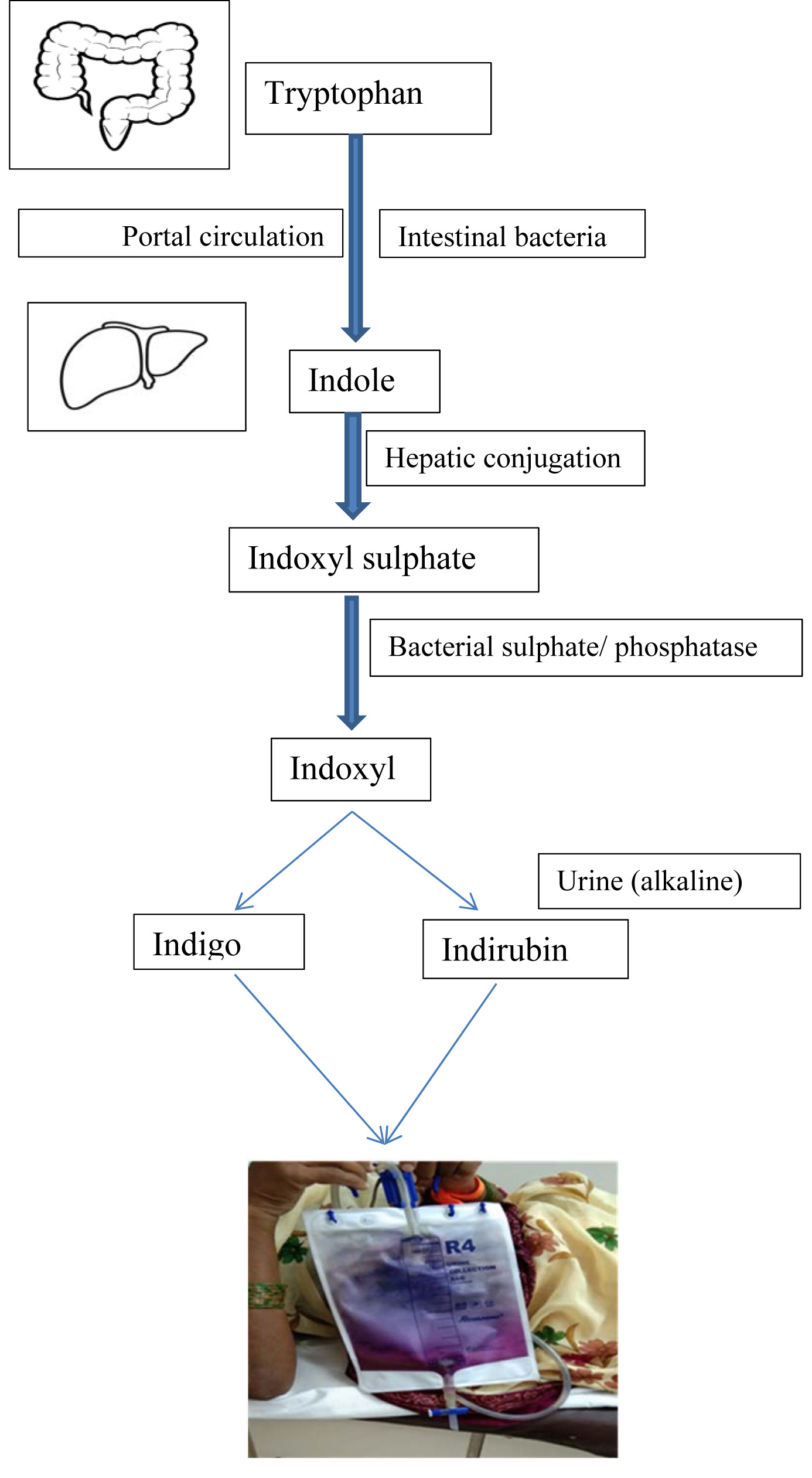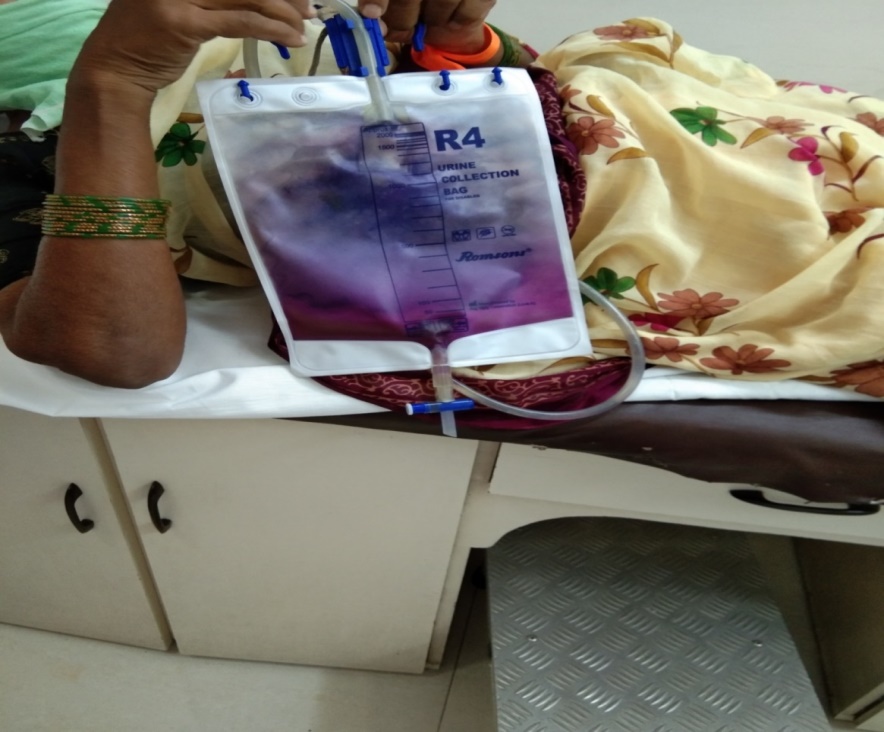Case Report
2022
March
Volume : 10
Issue : 1
Purple urine bag syndrome in catheter associated urinary tract infection: A case report
Pannala K, Panda A, Keshri SP
Pdf Page Numbers :- 39-41
Keerthi Pannala1, Arabind Panda1,*, and Shyam Prasad Keshri1
1Department of Urology, Krishna Institute of Medical Sciences, Secunderabad-500003, Telangana, India
*Corresponding author: Dr. Arabind Panda, Senior Consultant in Urology and Renal transplantation, Department of Urology, Krishna Institute of Medical Sciences (KIMS), Secunderabad-500003, Telangana, India. Email: arabindpanda@gmail.com
Received 5 October 2021; Revised 29 November 2021; Accepted 9 December 2021; Published 20 December 2021
Citation: Pannala K, Panda A, Keshri SP. Purple urine bag syndrome in catheter associated urinary tract infection: A case report. J Med Sci Res. 2022; 10(1):39-41. DOI: http://dx.doi.org/10.17727/JMSR.2022/10-8
Copyright: © 2022 Pannala K et al. Published by KIMS Foundation and Research Center. This is an open-access article distributed under the terms of the Creative Commons Attribution License, which permits unrestricted use, distribution, and reproduction in any medium, provided the original author and source are credited.
Abstract
Purple urine bag syndrome (PUBS) occurs in catheterized patients with bacterial urinary infections that produce sulphatase/ phosphatase. The presence of indigo and indirubin pigments, which are tryptophan metabolites, causes the purple coloring. After antibiotic therapy, the purple colour reverts to normal. We present a case report of unusual phenomenon occurring in a 60-year-old woman with carcinoma cervix. She did not have fever, constipation or a history of medication administration. She presented with purple urine in her indwelling long term supra-pubic catheter bag and sought a consultation with an urologist because the urine in her urine bag had changed color to purple. Awareness about PUBS will prevent unnecessary investigation and over treatment.
Keywords: purple urine bag syndrome; urinary tract infection; indigo and antibiotic therapy
Full Text
Introduction
The purple urine bag syndrome (PUBS) is a rare condition marked by the purple staining of an indwelling urinary catheter and other symptoms. While it was initially described by Dickson and Barlow in 1978, there is a report from 1812, of the urine of King George III being purplish-blue in color [1].
A PUBS is due to bacteria that convert tryptophan into indigo and indirubin and is linked to urinary tract infection [1, 2]. The purple coloring disappears after the infection is treated and the catheter is replaced [3]. Older patients, female’s patients in long-term care facilities, constipation, and alkaline urine are all established risk factors (Table 1) [2, 4].
Table 1: Risk factors for catheter associated urinary tract infection (UTI).
|
Prolonged catheterization
|
|
Female gender
|
|
Catheter insertion outside operating room
|
|
Other active sites of infection
|
|
Diabetes
|
|
Malnutrition
|
|
Azotemia (creatinine >2.0 mg/dl)
|
|
Ureteral stent
|
|
Antimicrobial drug therapy
|
Intestinal bacteria convert dietary tryptophan to indole, which is found in foods such as red meat, poultry, seafood, eggs, beans, and oats. Intestinal bacteria metabolize it and produce indole. Indole is subsequently transported to the liver and conjugated to indoxyl sulphate, which is excreted in the urine and converted to indoxyl by sulphatases and phosphatases generated by bacteria [5, 6] (Figure 1). Patients and family members can be trained to avoid over treatment by recognizing and treating symptoms early [7]. We describe the case of PUBS in an elderly woman on suprapubic catheter.

Figure 1: Pathogen of purple urine bag syndrome.
Case report
A 60-year-old lady with relapsed squamous cell carcinoma cervix stage IV, post chemotherapy and post radiotherapy had local recurrence in the pelvic floor with meatal involvement. She had suprapubic catheterization (SPC) for the urethral involvement with bladder outlet obstruction about a year back. She did not have fever, constipation or a history of medication administration. She had purple urine in her urobag which was persistent and recurred even after changing the bag (Figure 2).

Figure 2: Purple urine bag.
This discoloration was first noticed by her son at home approximately one day before the hospital consultation. The patient had a 20-Fr SPC in situ.
There were no abnormalities observed upon physical examination. Laboratory tests, including complete blood picture, and electrolyte levels, with other test results within normal limits. The urine culture showed significant growth of Escherichia coli, which was sensitive only to meropenem and amikacin. She was prescribed inj. meropenem 1000 mg IV twice daily for 7 days after which the purple urine color vanished and the urine became clear. Repeat urine culture showed no growth. Further antibiotics were not prescribed.
Discussion
Purple urine bag syndrome is caused by a urinary tract infection by bacteria that metabolize tryptophan metabolites to produce red and blue pigments [6]. The widely recognized PUBS hypothesis involves a series of responses that begin with the ingestion of tryptophan in the diet [7]. Long-term catheterization, urinary tract infection, and elevated tryptophan levels in the gut due to intestinal stasis or food consumption are all possible causes of PUBS.
Purple urine bag syndrome is associated with female gender, increased dietary tryptophan, increased urine alkalinity, severe constipation, prolonged catheterization, high urinary bacterial load, and renal failure [8]. These two pigments react with the polyvinyl chloride (PVC) in the tubing and urine bag, resulting in a purplish color in the urine. Common pathogens of PUBS include indoxyl sulfatase- and phosphatase-producing bacteria such as Escherichia coli, Proteus spp., Klebsiella pneumoniae, Providencia spp., Pseudomonas spp., Morganella spp., Enterococcus spp., and Citrobacter spp. [9]. Despite the fact that the illness is easily detected and treated, it is nevertheless a neglected entity, implying a significant underlying pathology.
Good catheter care and providing information to the patient and family about the nature and history of the problem is important [6, 10]. Although PUBS is normally a harmless condition, it can cause considerable morbidity as a result of urinary tract infections. The formation of a biofilm around the indwelling catheter, predisposing the patient to the condition [11].
Despite the fact that UTI is a risk factor and colonization in patients with long term indwelling catheter is common PUBS remains relatively rare [12]. This is attributable to a number of factors: Only when a certain amount of precipitation has been achieved will the purple discoloration become noticeable. The pH of the urine is also important, as alkalinity aids the discoloration process. However, PUBS has also been reported in patients without Indic anuria and acidic urine as well [13]. To increase the accuracy of urine culture results and remove the biofilm holding germs, the catheter should be changed before collecting urine.
Conclusion
Awareness about PUBS will prevent unnecessary investigation and over treatment. Good catheter care and education of patients with long term indwelling catheters is imperative for improved patient care. Obtaining a properly collected sample for urine culture is necessary for specific treatment. Empirical broad spectrum antibiotic therapy should be avoided.
Conflicts of interest
Authors declare no conflicts of interest.
References
[1] Khan F, Chaudhry MA, Qureshi N, Cowley B. Purple urine bag syndrome: an alarming hue? A brief review of the literature. Int J Nephrol. 2011; 2011:419213.
[2] Su FH, Chung SY, Chen MH, Sheng ML, Chen CH, et al. Case analysis of purple urine-bag syndrome at a long-term care service in a community hospital. Chang Gung Med J. 2005; 28(9):636–642.
[3] Pandey S, Pandey T, Sharma A, Sankhwar S. Purple urinary bag syndrome: what every primary healthcare provider should know. BMJ Case Rep. 2018; 2018:bcr2018226395.
[4] Al Montasir A, Al Mustaque A. Purple urine bag syndrome. J Family Med Prim Care. 2013; 2(1):104–105.
[5] Kalsi DS, Ward J, Lee R, Handa A. Purple urine bag syndrome: a rare spot diagnosis. Disease markers. 2017; 2017:9131872.
[6] Traynor BP, Pomeroy E, Niall D. Purple urine bag syndrome: a case report and review of the literature. Oxford medical case reports. 2017; 2017(11):omx059.
[7] Kalsi DS, Ward J, Lee R, Handa A. Purple urine bag syndrome: a rare spot diagnosis. Dis Markers. 2017; 2017:9131872.
[8] Mohib O, Roland T, Fontaine M, Laurent F, Rossi C. Purple urine bag syndrome is a rare manifestation of bacteriuria on bladder catheter: case report. African Journal of Urology. 2021; 27(1):1–4.
[9] Kumar U, Singh A, Thami G, Agrawal N. Purple urine bag syndrome: A simple and rare spot diagnosis in Uroscopic rainbow. Urology Case Reports. 2021; 35:101533.
[10] Lin CH, Huang HT, Chien CC, Tzeng DS, Lung FW. Purple urine bag syndrome in nursing homes: ten elderly case reports and a literature review. Clinical interventions in aging. 2008; 3(4):729.
[11] Trautner BW, Darouiche RO. Role of biofilm in catheterassociated urinary tract infection. Am J Inf Control. 2004; 32(3):177–783.
[12] Maki DG, Tambyah PA. Engineering out the risk for infection with urinary catheters. Emerging infectious diseases. 2001; 7(2):342.
[13] Bar-Or D, Rael LT, Bar-Or R, Craun ML, Statz J, et al. Mass spectrometry analysis of urine and catheter of a patient with purple urinary bag syndrome. Clin Chim Acta. 2007; 378(1-2):216–218.